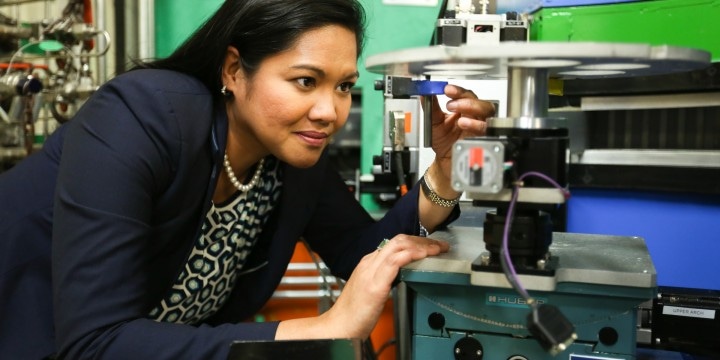Jun 21 2018
Oak Ridge National Laboratory’s Neutron facilities are helping researchers who are involved in finding ways to increase the power and efficiency of thermoelectric materials. These performance boosts could enable more economical and practical uses for thermoelectrics, with broader industry adoption, to enhance fuel economy in vehicles, advance body heat–powered technologies for smartphones and watches, and make power plants more efficient.
 ORNL Instrument Scientist Clarina de la Cruz used the HB-2A Neutron Powder Diffractometer at the High Flux Isotope Reactor to analyze a cobalt-doped thermoelectric material boasting a record increase in room-temperature performance. (Image credit: ORNL/Genevieve Martin)
ORNL Instrument Scientist Clarina de la Cruz used the HB-2A Neutron Powder Diffractometer at the High Flux Isotope Reactor to analyze a cobalt-doped thermoelectric material boasting a record increase in room-temperature performance. (Image credit: ORNL/Genevieve Martin)
Thermoelectric materials, usually metal compounds, can turn heat into electricity and vice versa in the presence of a temperature gradient, making them suitable for applications in waste heat recovery.
Thermoelectrics could take advantage of the huge quantities of unused waste heat created by industrial operations, commercial buildings, vehicles, fossil-fuel power generation, and even people by turning that “lost” heat into usable energy. But thus far their application has been restricted to add-on technologies because of their low efficiency compared with conventional forms of energy generation.
To reach targets set for standalone thermo-powered devices, researchers are currently looking deeper—down to the atoms - into potential materials and techniques to raise efficiency levels.
Experimenting with a magnesium-antimony–based material, an international research team guided by University of Houston physicist Zhifeng Ren has shown a considerable increase in the alloy’s power factor, or total energy output, with a method known as defect engineering. By replacing cobalt atoms at strategic sites, scientists changed the pathway for electrons in a way that greatly enhanced their mobility. Neutron analysis done at ORNL played a crucial role in confirming the method’s success.
The results, reported in Proceedings of the National Academy of Sciences, are commercially applicable with a figure of merit, or ZT value, of ~1.7 attained in thermoelectric efficiency. Most important is the material’s increase in power factor at room temperature with a record climb from 5 to 13 μW·cm−1·K−2 that more than doubled the total energy output of the material.
The ensuing power factor is far from the record of 106 at room temperature realized by Ren and others earlier, but the technique of boosting it could be applied to superior materials—principally those with a power factor already greater than 100—to make the most effective thermoelectrics even better.
The method functions by tuning the compound’s atomic structure to handle an inherent resistance in the flow of electrons that has restricted the potential of thermoelectrics. At the atomic level, thermoelectric effects take place when carriers, or electrons, move in reaction to temperature. As electrons travel through materials, they interact with atoms and get dispersed on a circuitous path instead of a direct route, which causes in inefficient energy conversion.
To create more heat or more power using thermoelectrics, research has commonly preferred two avenues—increasing carrier mobility or increasing the carrier number. Developing a material or changing a current material to house more electrons is one solution, though it is tough to alter a material while preserving its thermoelectric properties. Another option, chosen by the researchers, is to tweak the materials at the atomic level to even out the pathway for electrons to travel through with less resistance, thereby boosting the material’s power factor.
The goal is not to form more space in materials, but instead to finesse the inherent vibrations of atoms that rule their interactions with electrons by adding “defects” that are not inherently present. By cleverly placing the correct quantity of cobalt in the tweaked alloy, scientists are able to distribute the electrons in the alloy more efficiently.
“This is a sophisticated way of improving thermoelectrics from the bottom up by controlling the way electrons scatter through materials,” said ORNL’s Clarina de la Cruz, who collaborated on the research.
As an instrument scientist for the HB-2A Neutron Powder Diffractometer at the High Flux Isotope Reactor, de la Cruz led the neutron scattering study to examine the cobalt-doped Mg3Sb2 material.
An important objective for scientists was to identify the precise locations of the replacement cobalt atoms added to substantiate their role as electron scattering centers. The research would not have been possible without the use of neutrons and their exclusive, non-destructive capabilities for studying matter at the atomic level.
Neutrons were vital on account of the material’s complexity, explained de la Cruz. “To look at strategic substitutions on transition metals and identify very small concentrations of cobalt is no small task. Even without the added challenge of substitutions, some of these elements are so close together on the periodic table that deciphering them with x-rays or other methods is extremely difficult. You really need neutrons to solve this kind of problem.”
Neutron science has become an integral part of the loop in boosting the performance of thermoelectrics. Researchers around the world who are designing new materials use ORNL’s neutron facilities to verify and improve upon their results, in this case, fueling future energy security.
Clarina de la Cruz
The study is supported partly by the Solid-State Solar Thermal Energy Conversion Center, an Energy Frontier Research Center funded by the DOE Office of Science.
The High Flux Isotope Reactor is a DOE Office of Science User Facility. UT-Battelle manages ORNL for the DOE Office of Science. The single largest supporter of basic research in the physical sciences in the United States, the Office of Science is working to look into some of the most immediate challenges facing man.